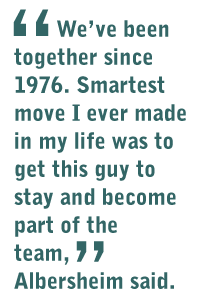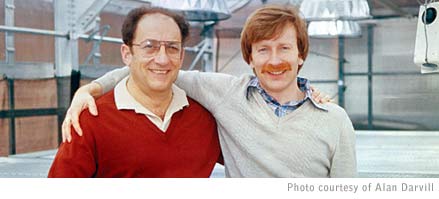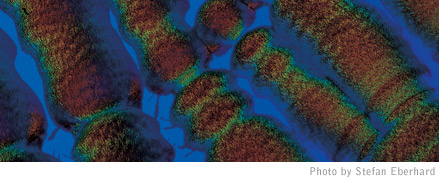


Sweet Dreams
by Kathleen Cason
Intro
| Charting the course
| The team's beginnings
| The pitch
Cross-country caravan
| The gathering
| Collaborations


The team's beginnings
By that tea time at the Goring Hotel, the pair had been working together for some seven years.
Eighteen years Albersheim’s junior, Darvill had earned a doctorate at University College of Wales,
Aberystwyth — one of Britain’s leading research universities in plant science. There he studied how
carbohydrates and plant cell walls were involved in controlling plant growth, an abiding interest
his lab continues to investigate.
“Peter’s group in Boulder, Colo., at that time, was publishing heavily in that field, so it was an
obvious place to try and go to after I finished my Ph.D.,” Darvill said.
Plus he and his wife, Janet, figured they needed to see the world for a year. They arrived in
Colorado with two suitcases and two carry-ons, not suspecting that they would never return to live
in England.
That first year stateside had its ups and downs.
For several months, Darvill worked on a cell wall project, making little progress. Just months away
from the end of Darvill’s funding, Albersheim called him into a meeting: The research would have to
be abandoned if something didn’t happen soon. In the nick of time, Darvill had a major
breakthrough. He and coworkers discovered two previously unknown cell wall carbohydrates.
Twenty-seven years later, Darvill and Albersheim’s lab continues to study these specific molecules
called RGI and RGII; just two years ago they uncovered the function of RGII (See Research Magazine
Summer 2002).
Albersheim recognized Darvill’s talent as a scientist.
“We’ve been together since 1976. Smartest move I ever made in my life was to get this guy to stay
and become part of the team,” Albersheim said.
They shared a strong drive for success, compatible scientific interests and similar goals, although
each had different personal styles.
“Al is a good leader and people like him,” Albersheim said. “I liked him and could trust him. He
could take criticism and build on it.”
They also became friends. Their families enjoyed backpacking trips and skiing together in the
Rockies. They traveled to Australia and Bora Bora together.
“We quickly formed a good, interactive group between us and it just progressed from there,” Darvill
said.

Peter Albersheim (left) and Alan Darvill forged
a partnership at the University of Colorado in
the early 1980s that led to the creation of the
CCRC at the University of Georgia.

Glucose is just one of many sugars that link
together to form complex carbohydrates. The
crystallized form of glucose as seen through
a light microscope is shown above. Seven
glucose units arranged in a specific way
form the molecule oligosaccharin,
which triggers defense reactions
in plants.
Intro
| Charting the course
| The team's beginnings
| The pitch
Cross-country caravan
| The gathering
| Collaborations
For comments or for information please e-mail the editor: jbp@ovpr.uga.edu
To contact the webmaster please email: ovprweb@uga.edu
![]()